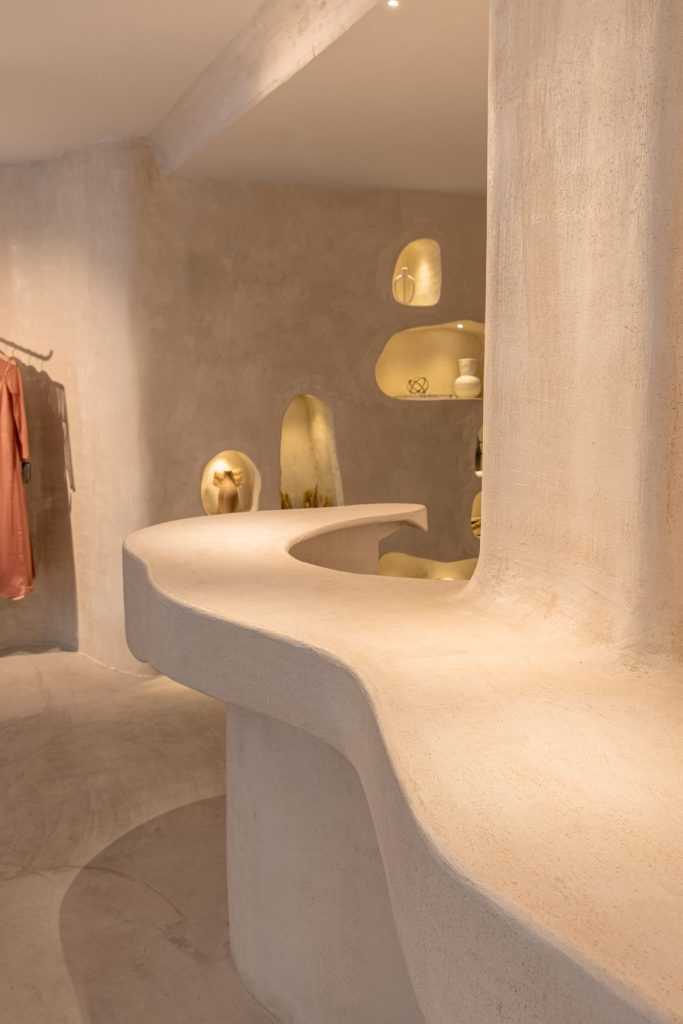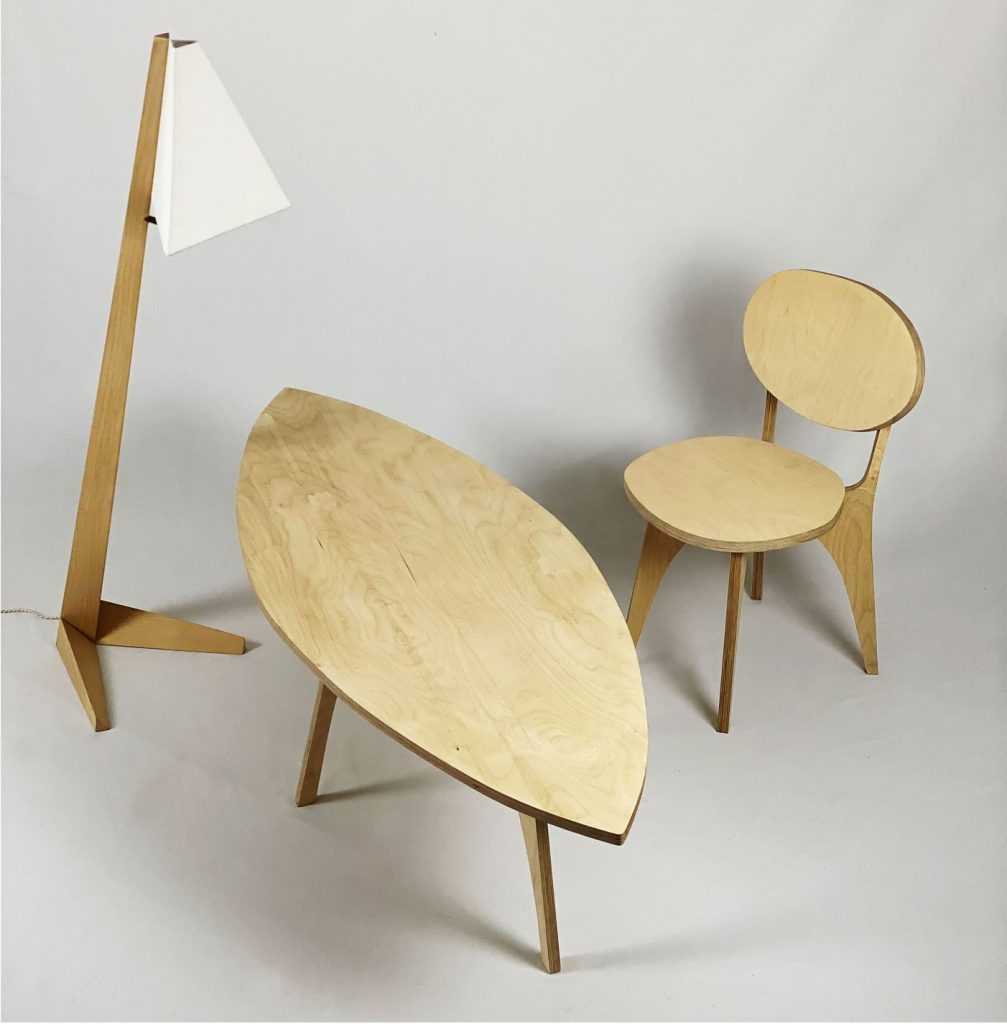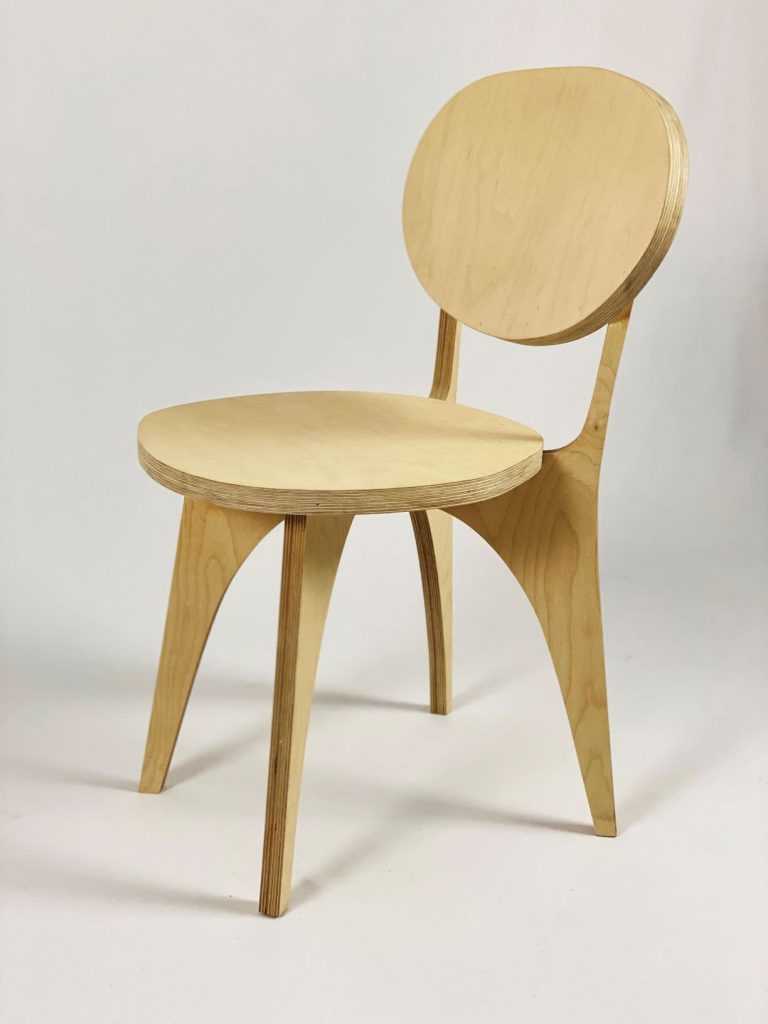Andreína Raventós Architecture: connecting to nature in new ways
“The art of living with pureness is a central idea in my designs represented in different ways, sometimes working with organic lines, raw textures, balance of volumes or simply working with the light.” Andreína Raventós.

Andreína Raventós of architecture and design studio Andreína Raventós Architecture has a keen understanding of how a restrained palette, texture, and space work together to create a sense of tranquility. Inspired by sources ranging from spaceships to the Indigenous culture of her Venezuelan roots, her interiors possess a clarity that is as much about the objects as the spaces that frame them.
The Projects
Boutique Mattuî Collection (2022)
The MATTUÎ Collection fashion boutique in the Las Salesas district of Madrid is a perfect synchronicity between the design elements and the brand’s fashion aesthetic. The pieces from this made-in-Spain brand and the pared-back interior architecture that features natural, organic, and hand-made elements have the artisanal hand.


Lime mortar, plaster, and glass provide the perfect backdrop to the subtle hues of the fashion collections. Recessed spaces for display are seamlessly integrated into the design and minimize visual clutter.


Accessories are scattered throughout the boutique, each of which makes a specific textual contribution.

Photography by Joanna Herrera.
“AR 18” (Casa Decor 2023)

Inspired by spaceships, AR 18 was Andreína’s space for the 58th edition of Casa Decor, Spain’s premier showhouse that takes place every year in Madrid. A look to the future, this spaceship home is a proposal for what homes can look like if we maintain the current pace of technological advancement. The brief was to design a small space with everything for daily living that can also be used as transport to other planets.
In just 18 square metres, it consisted of two central modules with a kitchen, bathroom, and bedroom. Curved kitchen countertops facilitated passage from one side of this home to the other. Curtains provided privacy for the bathroom area. The bedroom was elevated above the central bathroom to recreate the look and feel of a spaceship.

A black starry ceiling injected a futuristic setting, acting as a counterpoint to the mainly white palette.

Andreína used sustainable materials, such as recycled glass mosaic floor from Spanish firm Hisbalit, a sintered natural stone countertop, and recycled textiles. She collaborated with Niessen for the home automation mechanisms and touch screen, Bathco for the sink, and Galindo Taps for the taps.
The project won third place in the category of “Best Use of a Design” at Casa Decor 2023 for the glass mosaic tile flooring.
Photography by Asier Rua for Casa Decor.
“The essential. The art of living” (Casa Decor 2022)

This space was Andreína’s project for the 57th edition of Casa Decor. In 24 square metres with a living, kitchen, dining, sleeping and bathroom areas, she designed it as a modern cave to inspire spirituality, creativity, social life, and joy. She sought to create a refuge for self-understanding and self-reflection.

Andreína selected interior elements made of natural and sustainable materials to inspire visitors to reconnect with the earth. She updated clay and lime mortar, two of the oldest building materials, for contemporary use.


The modular teppanyaki plate is by Siemens, the clay mortar by Ecoplay, the textiles by Texathenea , the kitchen taps by Blanco, the bathroom taps by Tres Griferías, and the home automation by Zennio.

Photography by Luis Helva for Casa Decor.
The project won third place in the “Public Favourite” category at Casa Decor 2022.
Madrid Penthouse (2019)

This penthouse in the upscale Salamanca district of Madrid underwent a gut renovation. The design brief was to create an open layout where one space flows seamlessly into another. The material palette include wood and clay. The furniture pieces are custom. The large windows provide panoramic city views.

In the kitchen area, curvaceous flooring in the two-level eating area complements the organic form of the countertop. Regular height chairs provide seating on one side of the island and bar chairs on the other. In the dining area, the table, which seats ten, and the chairs also accord with the curvilinear shape of the design elements.

The chairs are from Andreína’s Piaroa collection.

In the bedroom, the headboard connects to the desk. The headboard textile is a custom design by Andreína. Piaroa collection lamp and chair.

The bathroom, a small oasis surrounded by tropical plants, extends beyond the home, bringing the outdoors in. The bathtub and shower are enclosed in glass, allowing fantastic city views.


Photography by Andreína Raventós.
The Objects
Piaroa Collection (2020)

The inspiration for the collection is the Piaroa tribe from Venezuela. The collection consists of a table, lamp and chair made from birch plywood because of its aesthetic quality and high resistance. The pieces are joined by wood, not metal, a deliberate design choice because the Piaroa do not work with metal. “I am honouring my ancestors, their know-how and the respect they had for the environment” says, Andreína.
The sources of inspiration are the “Churuata”, the traditional Indigenous house, for the lamp, the bow and arrow for the chair and canoes for the coffee table.

Andreína presented the collection at the SaloneSatellite 2022, an exhibition at the Salone del Mobile. The SaloneSatellite features works by creatives under 35.

Infinighty Collection (2023)

The sculptural Infinighty lighting collection represents the path of life with its ups and downs. Continuity and light show us the way. Handmade with natural materials, the imperfection exalts the imperfections of the human process. The beauty of these unique pieces is that, just as in life, one’s perception changes depending on the angle from which a piece is viewed.

Users can regulate light intensity from a phone to create different environments.

Andreína presented the collection at the 2023 SaloneSatellite. It was one of ten from Satellite to be selected for a special sale at the the Milan location of the high-end Italian department store La Rinascente.
Photos by Andreína Raventós.
The Studio
Andreína recounted her firm’s beginning, her sources of inspiration, and her design process.
Briefly describe the firm and its beginnings.
After I graduated from architectural school, I went to work in Switzerland. I had a bad experience that made me want to start something really quickly by myself. I returned to Madrid, and began my first project. I needed to create with a sense of freedom to make my career worthwhile. I started to reconnect with design, and other projects followed. Every project is unique. I conceive projects with complete freedom, but with clients’ needs in mind. I always draw the first sketches by hand to feel connected with my intuition. This method helps me find the solutions I seek. I could never begin a project by using a computer. I approach projects from an artistic viewpoint with a need to find an esthetic balance.
Your our origins are Venezuelan. Is there a regional tradition or reference with respect to your technique, design, or inspiration, whether from Venezuela or Spain?
I have a thing for Caracas modern architecture. The constructions from the beginning of the twentieth century are fascinating. I grew up with a house that was open to the exterior. The windows were always open. The sound of cars or birds were in the background. Even the smell of the rain would be part of the atmosphere of the home. My school had open bricks. Whenever it rained, we would have to move the desks a little away from the façade. My mom grew up in a house with an open patio in the middle, with no separation walls. It was full of plants, giving the feeling of total immersion in nature. This connection with the exterior is something I try to create in my designs. The idea of the art of living is what I always try to reference. Spaces that impart joy and calm at the same time.
What inspires you most when you design?
I get inspiration from many things. A fantasy image, interesting materials, conversations… I love when I start to work without inspiration. I later get a sense of it and, after some drawings, it starts to make sense. I believe there are small sources of inspirations that are in my head that, together, make sense.
How do you integrate the hand of the maker or artisan in your work, as opposed to the machine?
I love to integrate artisan work in my designs. I think it is important to exalt the imperfections of the human process. They invite us not to be perfect. Also, craft trades need to be alive to have continuity from generation to generation.
How does your firm integrate environmental considerations into processes?
I try to use the most natural materials since there are so many, and they are beautiful with fantastic properties. I am happy that many companies are doing their best to make processes less harmful to the environment. Sometimes, the products are natural, but manufacturing processes are not. It is important to know this.
Have you incorporated or thought about incorporating universal or accessible design in your work?
I recently designed the Infinighty collection of lamps that can be controlled by the phone. You can graduate the intensity of light and turn it on and off with a simple gesture.
Why do you think accessible design is important, not just for users but for the general public?
There is not enough consciousness about accessible design, and its integration must be of general concern. It is important for disabled people and for people who help them.
Are there any notable recent events, recognition (awards), or developments?
I have participated in Casa Decor since 2022 and at the Salone Satellite in Milan. I won an award in the “Public Favourite” category, which was really exciting for me. At Casa Decor 2023, I received an award for the integration of a product in my space, which was really exciting because I was out of my comfort zone working with shiny materials.
Your dream project would be…
I would love to work on a park project. To experiment with working on a large scale of landscape and with vegetation. I would also like to work on a co-living project since it is a new way of approaching housing. New ways of life demand new ways of living because of technology and new ways of thinking.
What are your favorite spots in the city that you live in? (galleries, museums, hotels, shops, restaurants)
Madrid is home because I have lived there for a long time. I love it because it is alive and fun. I visit Caixa Forum every once in a while to check out new exhibitions of all types. I also love to go around Huertas to eat tapas at authentic tabernas, such as Taberna el León de Oro or Cervantes Cervecería, visit Real Fábrica, which is a store with Spanish products and visit El Angel del Jardín, a cozy flower shop situated in an old cemetery. One of my favourite spots to disconnect and see the sunset is the Parque de las Siete Tetas, where you get a full view of the city.
Speak about marrying cutting-edge technology and raw materials.
Technology provides new ways of doing that help us think in a different way when designing. We need to explore cutting-edge materials as new ideas can only come from this approach. The latest technology processes can optimize the use of raw materials so that they can be more sustainable and provide us with the possibility of mixing materials to create new designs.

